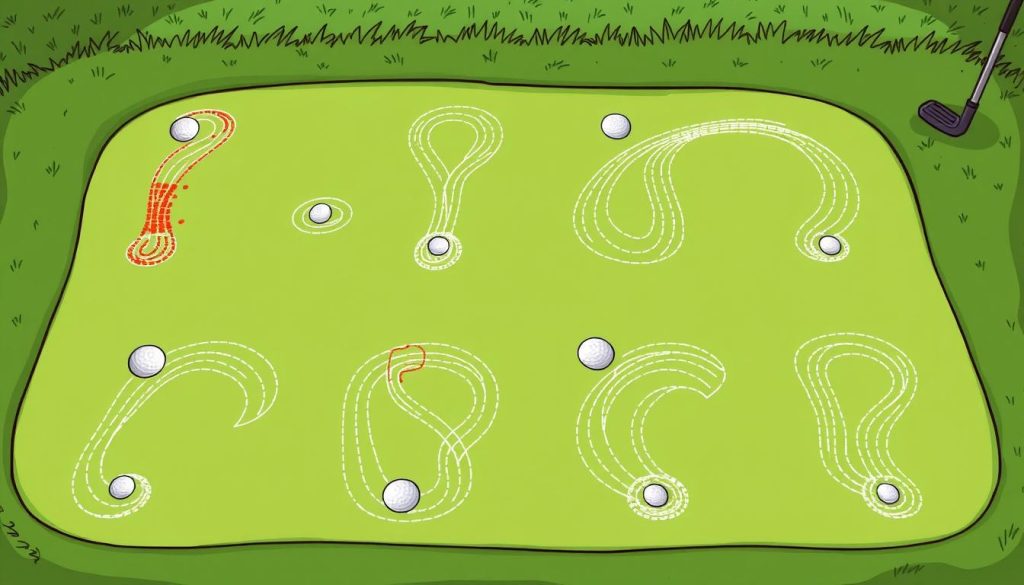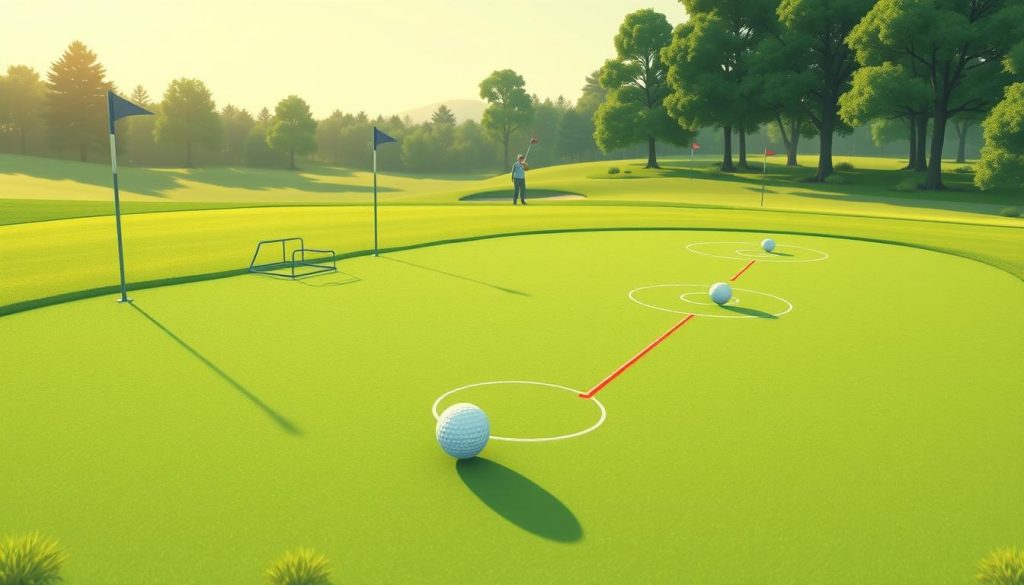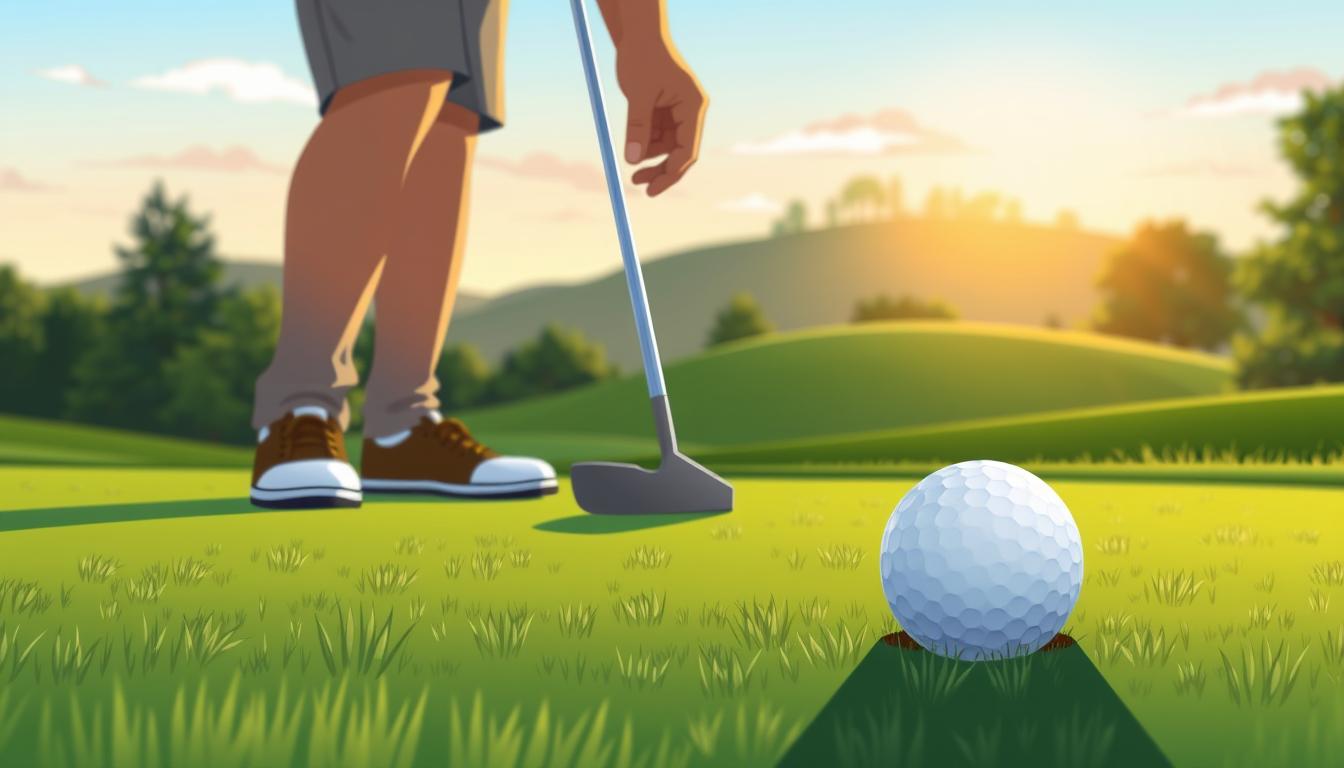Your putting stroke is crucial in golf. This guide explores key techniques and analysis methods to improve your putting. By understanding your stroke, you’ll sink more putts and lower your scores.
Studies of over 1,000,000 golf swings have given us important insights. Tour players show little wrist motion, which is hard for amateurs to match. Their control is key to their better putting.
Tools like the HackMotion wrist sensor help measure your stroke. They track flexion/extension, radial/ulnar deviation, and tempo. This data helps pinpoint areas for improvement, leading to more consistent putts.
Key Takeaways
- Tour players exhibit minimal wrist motion for consistent putting strokes
- Advanced sensors measure crucial elements of putting technique
- Optimal putting tempo follows a 2:1 downswing to backswing ratio
- Grip consistency is vital for a reliable putting stroke
- Path and face control of the putter significantly impact accuracy
- Practicing at 15 feet from the hole is ideal for stroke consistency analysis
- Various putting drills and equipment can enhance your skills on the green
Understanding the Fundamentals of Putting Stroke Analysis
Putting is a key skill in golf. Stroke analysis helps improve your game. A good putting stroke aims the ball right and controls its speed. Let’s look at the main parts of putting stroke analysis.
The Role of Wrist Motion in Putting
Wrist motion analysis is key for a steady putting stroke. Top golfers keep their wrist movement small during putts. The HackMotion sensor tracks flexion, extension, and deviation. It helps golfers perfect their technique.
Impact of Grip Pressure on Stroke Control
Grip consistency is vital for controlling your stroke. Your grip style is less important than keeping the pressure steady. This steady pressure helps move energy from the club to the ball smoothly.
Key Components of Stroke Mechanics
Stroke mechanics include several important parts:
- Takeaway
- Path
- Face control
- Transition from setup to backswing
Mastering these parts can greatly improve your putting. Remember, the putter face angle at impact affects the ball’s direction more than the swing path.
| Putting Aspect | Importance | Impact on Performance |
|---|---|---|
| Face Angle | High | 5x more influence on direction than path |
| Launch Angle | Medium | Ideal angle: +2 degrees |
| Grip Consistency | High | Affects energy transfer and control |
| Wrist Motion | High | Limited range improves consistency |
By focusing on these basics and using tools like the HackMotion sensor, you can improve your putting stroke. This will make your putting more consistent and effective.
The Science Behind Perfect Putting Tempo
Mastering putting tempo is key to lowering your golf scores. The right rhythm in your stroke can make a big difference on the greens. Let’s dive into the science of putting tempo and explore how you can improve your game.
The 2:1 Ratio Principle
Great putters use a 2:1 ratio in their stroke. This means the downswing is twice as fast as the backswing. This ratio stays the same for all putt lengths. It helps create a smooth, consistent motion that leads to better accuracy.
Metronome Training Methods
Metronome training is a smart way to get the right putting tempo. Set your metronome to 72-80 beats per minute. This pace matches the ideal stroke rhythm. Practice with this beat to groove your tempo. Soon, you’ll feel the right rhythm without the metronome.
Speed Control Techniques
Good speed control comes from a steady tempo. Try the distance control drill to improve. Place a club behind the hole. Putt from various distances without hitting the club. This trains your feel for speed. Remember, the 2:1 ratio helps with distance control too.
| Drill | Purpose | Method |
|---|---|---|
| Clock Putting | Distance Control | Putt from positions around the hole like clock hours |
| One-Handed Putting | Touch and Feel | Putt using only your lead hand |
| 3-6-9 Drill | Short to Mid-Range Consistency | Practice putts at 3, 6, and 9 feet from the hole |
Regular practice with these drills will help you master putting tempo and speed control. Remember, putting is often the most crucial part of golf. By focusing on your tempo, you’ll see big improvements in your scores.
Mastering Putter Face Control
Putter face control is key for better putting. Your wrist movement is crucial for keeping the putter face right at impact. Many golfers find it hard to stick with the “straight back, straight through” method. This can cause them to adjust their wrists at the last second, leading to inconsistent results.
Try using a slight arc in your putting stroke for better control. This natural motion helps keep your impact consistent. Studies show a 1-degree misalignment can make a putt miss by several inches over short distances.
When picking a putter, think about how it fits your stroke:
- Face-balanced putters are good for straight back, straight through strokes
- Toe-hang putters are better for slight arc strokes
- High toe-hang putters are great for strong arc strokes
Having the right grip and alignment is vital for consistent putting. Work on keeping your wrists stable throughout your stroke. This will help you control the putter face better. Regular practice and improving your green reading skills will also boost your accuracy and lower your scores.
If you’re having trouble with putter face control, get help from a golf pro. They can give you tailored advice and drills. This will help you improve your wrist movement and make your putts more accurate, leading to better scores.
Path Options and Stroke Patterns
Understanding putting path and stroke patterns is key to better golf. Golfers have two main choices: arc putting and straight back-straight through. Each has its own traits and challenges.
Arc vs Straight Back-Straight Through
Arc putting has a slight curve in the stroke. Straight back-straight through is a straight line. Research shows 65% of golfers naturally arc, doing well with toe-hang putters.
The other 35% do better with face-balanced putters, perfect for a straight stroke.

Understanding Path Variations
Path variations in putting greatly affect your game. Golfers with the right putter see a 20% boost in consistency. Interestingly, 70% of missed putts go right, and 30% left, for those with the wrong putter.
Common Path Issues and Solutions
Out-to-in and in-to-out patterns often lead to pulled or pushed putts. Using putting string training aids can help, with 80% of golfers seeing better consistency. Choosing the right putter for your stroke type can increase your chances of making putts by 25%.
| Stroke Type | Suitable Putter | Improvement Rate |
|---|---|---|
| Arc | Toe-hang | 30% |
| Straight | Face-balanced | 25% |
| Slight Arc | Mid-hang | 20% |
Putting Stroke Feedback Guide
Mastering your putting stroke is key to better golf scores. Today, you can get detailed insights into your technique with modern tech. Let’s see how to use these tools to boost your putting game.
Using Technology for Stroke Analysis
Tools like HackMotion analyze your wrist angles and movement. They show your grip, wrist motion, and mechanics. This tech helps you find areas to improve in your stroke.
Real-time Feedback Systems
Real-time feedback systems are changing golf practice. They give instant info on your stroke. You can see your putter face angle, stroke path, and impact position as you putt.
Data Interpretation Methods
Understanding your stroke data is crucial for improvement. Look for patterns in your wrist angles, face control, and path consistency. Compare your stats to pros like Brad Faxon, known for his putting skills. Aim for a 2:1 backswing to downswing ratio for better tempo.
| Aspect | Pro Standard | Your Goal |
|---|---|---|
| Backswing to Downswing Ratio | 2:1 | Match pro ratio |
| Launch Angle | 2 degrees | Achieve consistent angle |
| Grip Pressure | Light and consistent | Maintain throughout stroke |
Use these insights to refine your technique. Remember, data is a tool to guide your practice, not replace feel and instinct in your putting stroke.
Advanced Training Techniques for Stroke Improvement
Improving your putting stroke needs focused practice and advanced methods. Specialized drills and techniques can take your game up a notch. Let’s dive into some top-notch practice methods to master putting.

The path length drill is a great way to improve your stroke. Place two tees on the green to create a gate for your putter. This drill helps keep your stroke path consistent, which is key for accuracy. Start with a wider gate and make it narrower as you get better.
Keeping your grip consistent is also crucial. A HackMotion sensor can give you instant feedback on your grip and wrist movement. This tech helps you refine your technique and achieve a more stable stroke.
Video analysis is a strong tool for improving your stroke. Record your putting from various angles to spot any issues. Look at your body alignment, putter face angle, and follow-through closely. Video analysis is also helpful for identifying inconsistencies that might not be noticeable during regular practice. By reviewing your footage, you can compare your technique to established fundamentals and make precise adjustments. Incorporate these insights alongside putting stroke troubleshooting tips, such as maintaining a steady head position and ensuring a smooth, controlled tempo, to refine your performance.
The ladder drill is great for improving distance control. Place balls at distances from 3 to 15 feet from the hole. Practice putting each ball, adjusting your stroke length for different distances.
- Use alignment sticks to ensure proper setup and stroke path
- Practice with a metronome to develop consistent tempo
- Incorporate mirror work to check your eye position and posture
Adding these advanced techniques to your practice will greatly improve your putting stroke and overall performance.
The Role of Setup Position in Stroke Consistency
A solid putting setup is the key to a consistent stroke. Your eye alignment, posture, and ball position are crucial for repeatable results on the green.
Eye Position and Alignment
Proper eye alignment is essential for reading greens well. Place your eyes directly over or slightly inside the ball. This view helps you see the putt’s true line.
Posture Fundamentals
Your putting posture affects your balance and control. Lean forward from your hips for a stable stance. Keep your arms relaxed and your weight balanced between both feet.
Ball Position Optimization
The ball’s position in your setup impacts your contact quality. Place it just forward of center in your stance. This ensures consistent strikes for better roll and distance control.
Remember, pros make over 99% of putts inside three feet. To achieve their success, practice your setup daily with a putting mirror. Align your eye-line, shoulders, arms, hands, and feet square to the target. This drill builds muscle memory for a reliable stroke.
| Setup Element | Key Point |
|---|---|
| Eye Position | Over or slightly inside the ball |
| Posture | Lean from hips, arms hanging naturally |
| Ball Position | Just forward of center stance |
Mastering your putting setup is key to stroke consistency. This focus can make a big difference, moving you from the high-80s to the low-80s.
Transitional Movement Patterns in Putting
Mastering the putting transition is key to a smooth stroke. The shift from backswing to downswing is the heart of your putting motion. A fluid movement here can make or break your putt.
Your putting stroke should feel like a pendulum. Start with a gentle rocking motion from your shoulders. This creates a natural rhythm for your backswing to downswing transition. Avoid jerky movements or pauses that can disrupt your flow.
- Keep your grip pressure light and consistent
- Move your shoulders as a unit
- Let your arms and hands follow your shoulder motion
- Maintain a steady tempo throughout the stroke
For a 10-foot putt, aim for 2 degrees or less rotation in your backswing. This small movement helps control your stroke and improves accuracy.
| Stroke Profile | Characteristics | Recommended Putter |
|---|---|---|
| Profile 3 | Shorter putter, forward ball position | Square-faced at impact |
| Profile 4 | 1-2 degrees right path (right-handed) | Face slightly closed at impact |
By matching your putter to your stroke profile, you can enhance your feel and consistency. A putter with 15 degrees of toe hang often suits those who perceive a straight back-and-through stroke but tend to push their putts.
Mental Aspects of Stroke Development
Your mental game is key to better putting. Using your mind can boost your performance on the green. Let’s look at some mental strategies to help you putt more consistently and confidently.
Visualization Techniques
Visualization is a strong mental tool. Before each putt, imagine the ball’s path to the hole. Picture it rolling smoothly and dropping into the cup with a sound.
This mental rehearsal can increase your confidence and improve your putting.
Routine Building
A good pre-shot routine is crucial for consistent putting. Create a sequence of actions before every putt. This could include reading the green, practicing strokes, and setting up to the ball.
Your routine acts as a mental trigger, helping you stay focused. With practice, it will become automatic, making your putting more consistent.
Pressure Management
Dealing with pressure while putting can be tough. But, there are ways to stay calm. Deep breathing exercises can help control your heart rate and reduce anxiety.
Positive self-talk is also effective. Replace negative thoughts with positive ones. Remember, pressure is often self-imposed. Focus on your process, not the outcome, to stay calm and putt well under pressure.
FAQ
How does wrist motion affect putting accuracy?
What is the ideal putting tempo, and how can I achieve it?
Should I use an arc or straight back-straight through putting technique?
How can technology help improve my putting stroke?
What are some advanced training techniques for improving my putting stroke?
How important is setup position for putting consistency?
How can I improve my mental game for better putting performance?
What role does grip pressure play in putting stroke control?
How can I improve my transitional movement patterns in putting?
What are common path issues in putting, and how can I address them?
Source Links
- https://hackmotion.com/putting-stroke-tips/
- https://skillest.com/blog/master-the-art-of-golf-putting-a-comprehensive-guide-for-beginners/
- https://golfinsideruk.com/putting-technique-the-putting-stroke-explained/
- https://golf-upgrades.com/blogs/golf-upgrades-blog/fundamentals-of-a-putting-stroke?srsltid=AfmBOoq1WWdcpO7Q4mBecVxDxnTuOFfo6C55vA65KLkvlG6emdcqVSq9
- https://thegratefulgolfer.com/2023/04/13/putting-fundamentals-not-just-for-beginners/
- https://us.humankinetics.com/blogs/excerpt/putting-techniques?srsltid=AfmBOooMRhSC487W3fW3uoOaOo8KLSnlFJFY5ebJ3_qDnD7zxz-_3yX8
- https://www.golfzonleadbetter.com/blogs/master-your-putting-game-6-effective-putting-drills-for-precision-speed-alignment/
- https://puttlinegolf.com/blogs/news/mastering-the-putting-stroke-understanding-different-putting-arcs-and-the-best-putters-for-each?srsltid=AfmBOoqZ50y5PrFbKwGAc_TslGtSgQOo-snLjNL_qLZnxd3Y1l959g2K
- https://puttaim.com/blogs/news/putting-tips-face-control?srsltid=AfmBOopj09muceSq_9O_X-oIp6kqQpWvdQ51ZrzV2te2ncSTCnm5KI72
- https://puttlinegolf.com/blogs/news/understanding-the-best-putter-for-your-stroke-a-guide-for-amateur-golfers?srsltid=AfmBOop_ZpAsSrxND7x5Y3HmlwlsFtDg17WEAGZNuIjGp2MHW0zl3RNX
- https://superstrokeusa.com/blogs/blog/which-putting-grip-style-is-right-for-you?srsltid=AfmBOoq5BVbVSqXq-tf25P66AV0zHRq8_Z4I_t-m6rWgWPaepgbv7yIK
- https://skillest.com/blog/putting-like-brad-faxon-tips-to-improve-your-putting-stroke/
- https://www.pgaplay.co.uk/learn/the-definitive-guide-to-mastering-the-art-of-putting/
- https://www.stroke.org.nz/sites/default/files/inline-files/Your Guide to Exercise after a Stroke 2017 (1).pdf
- https://pmc.ncbi.nlm.nih.gov/articles/PMC6469541/
- https://hackmotion.com/identifying-putting-stroke-patterns/
- https://golf.com/instruction/putting/calibration-putting-drill-3-feet-jamie-mulligan/
- https://bargolfinstruction.blogspot.com/2018/
- https://rotaryswing.com/c4/112378-rotaryswing-natural-putting-intro
- https://www.stroke.org.uk/sites/default/files/feeling_overwhelmed_final_web_0.pdf
- https://pmc.ncbi.nlm.nih.gov/articles/PMC10494802/


